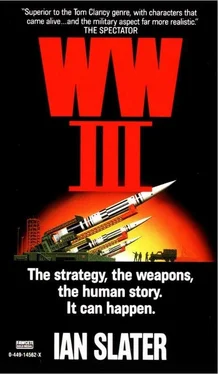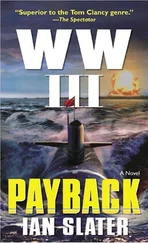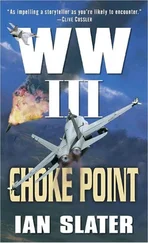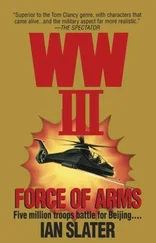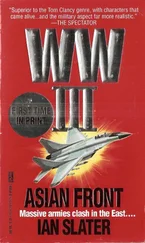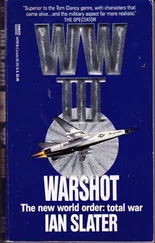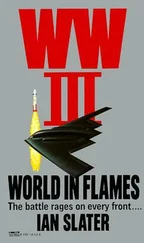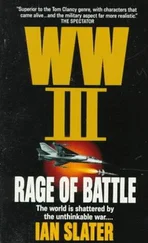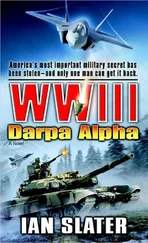“Twenty-six. Why?”
“Good number to stay away from,” the marine said.
In Germany, the British Army of the Rhine was fighting for its life in the fifty-five-mile-wide pocket between Bielefeld and Dortmund, where swarms of Sukhoi-24 Fencer ground-attack fighters were wreaking havoc on the British tanks.
The Sukhois, chosen in part for the relatively narrow swept wing width, and painted in green-brown blotch camouflage, had been crated by rail through Poland and the GDR weeks before, reassembled, parked and maintained in the vast Nordhausen tunnel complex in the eastern part of the Harz Mountains, where Hitler had made his V–Is and V-2s out of range of Allied bombers. Rising swiftly, behind a semicircular screen of SAM sites in the Harz foothills between Nordhausen and what had been the West German frontier, the Fencers streamed northeast over Stolberg. Swooping down through cloud over the tranquil bluish green of the Harz, they reached the British army’s defensive position a hundred miles west along the Bielefeld-Dortmund line in less than nine seconds, their terrain-avoidance radar and laser target-seekers cutting through the battlefield’s smoke cover, setting the Challenger tanks ablaze.
When the Challengers fired, their aim was deadly, and they fought hard, even as they fell back northward behind the Weser and Mittelland Canal. The British were taking terrible punishment as well on their southern flank, where East German motorized shock troops were now crossing in force, so that in the depression between Bielefeld and Dortmund, what had been a fifty-five-mile-wide defense base now shrank to thirty-five miles.
As the Russian Fighter/Interceptors streaked down, pouring a deadly hail from twin-barreled twenty-three-millimeter cannons, a British commander watched his battalion of forty tanks and support infantry being systematically destroyed. Here, unlike Fulda, where American and Russian tanks were too close, the Soviets’ gasoline bombs tumbled down — and with such apparent aimlessness, it seemed they could do no harm. Then the big silver “jelly beans” would burst, the saffron fireballs rolling over the velvet green hills. To the men inside the Challenger tanks, whose reactive armor had worked so efficiently in blowing up the Soviets’ earlier high-explosive antitank bullets, the napalm was an agony worse than any gunfire, their bodies becoming torches, all but impossible to extinguish. As one man would try to smother a comrade to snuff out the flame, the jellied gasoline would fly onto the would-be rescuer, the droplets of red-hot mercury sticking to flesh and clothing — often as not, killing two men instead of one. On many occasions British infantry caught by the napalm not only died a screaming death themselves, but proved deadly to comrades as the heat from their burning bodies set off their own ammunition.
The Soviet Fencers supporting the GDR advance did not have it all their own way as the NATO air forces rose to meet them. But the overwhelming numbers of Soviet and Warsaw Pact fighters meant that the NATO fighters trying to contain breakthroughs on the Northern Plain, in the center along the Fulda axis and in the south on the alluvial flats of the Danube, were stretched too thinly, the NATO commander not knowing where the twenty Russian divisions held in reserve would be thrown in, therefore unable to concentrate wholly on any one sector.
It was a Soviet-Warsaw Pact strategy designed for the quick win, to push NATO so far, so quickly, that in the case of a ceasefire ranovato— ”early in the game”—the Soviet-Warsaw Pact would have in its possession at least a third of West Germany and a sizable strip of Holland 50 miles wide and 130 miles long north of NATO’s air-control center at Gelsenkirchen.
The NATO pilots were exacting a high price, but against all the other intangibles of battle was the stark mathematical fact, known for years before the war, that NATO could not outlast sheer quantity, even with a kill ratio in the air of two to one in the first seventy-six hours.
On the ground the situation was worse, the tank commanders facing Sergei Marchenko and the other ten thousand Soviet tanks having had to maintain a four-to-one kill ratio merely to hold ground.
In the wake of the Soviet-Warsaw Pact three-pronged attack, the old confident air among NATO commanders about Western quality versus Russian quantity took on a decidedly hollow ring.
* * *
Leading three other F-16s, one of the NATO pilots, Colonel Delcorte, his F-16 still climbing though getting low on fuel, was in his fourth sortie within seven hours. Based in Hahn with the U.S. Tenth Tactical Wing, Delcorte now had only fourteen of his twenty-six-plane squadron left. Ten were downed outright; two had managed to return to Hahn but were badly shot up.
Of the ten downed planes, three reported bailouts: one’s chute was seen high above Fulda Gap, presumably drifting down over East Germany, the other two pilots picked up southwest of the Bielefeld-Dortmund basin in a heavily wooded section serving as revetment areas for the battered Chieftains. The British-made battle tanks, which, though first-rate and well armed with 120-millimeter cannons and assisted by crack British infantry regiments from the Army of the Rhine, were doomed because of their slower speed compared to the Russian T-90 A’s seventy-five kilometers per hour. Had the Chieftains more time to dig in, it might have been a different story, for as Sergei Marchenko and fellow S-WP tank commanders quickly realized, the breakdown rate of the Soviet tanks was much higher than for those of the Allies. But though the British Chieftains were well served by their appliqué Chobham armor packs and first-rate crews, they could not overcome the Russians’ three-to-one superiority in tanks.
At Fulda Gap, where the Russians had been unable to use their jellied gas bombs, the latest British Challengers, German Leopard IIs and American M-1s lasted much longer in battles where foam-filled, self-sealing rubber fuel tanks took many direct hits from armor-piercing shots without exploding.
In the Bielefeld-Dortmund area, The Russian T-90s, built to accommodate the shortest Russian tank crews and so presenting the lowest silhouette of any main battle tank, swung out wide through the British Chieftains’ heavily laid white smoke screens and regrouped in ambush, isolating several Chieftains at a time. In the process, the smoke- and dust-filled battleground confused the pilots of the American Thunderbolts, who had to make split-second differentiation between Russian and British tanks — this becoming increasingly difficult in the dense smoke as the day wore on. It was, Delcorte thought, his F-16 leveling out high above the smoke, as terrible, or from the Russian point of view, as good, an example of using superior numbers as you could get, quite literally mugging the opposition with sheer brute force and size.
The only hope, Delcorte knew, was to keep going up, keep engaging them until the Juggernauts’ attack was blunted, when finally there would be so many tanks off tread, so many automatic shell extractors in the T-90s out of alignment due to overheating and crews’ fatigue, that the West’s overall superiority in technology, including more tank transports, would start to pay off. Delcorte took some hope from the fact that NATO’s Medevac and air crew rescue units were of uniform high quality. This was a crucial factor if NATO pilots were to fly and fight again. Delcorte and the other three F-16s in the finger four formation, resembling the spacing of a right hand’s four fingertips, the little finger farther back, entered heavy cloud. At six thousand, Delcorte was still in it, the other three pilots in the clear, the wingman on his left advising him there were “Bogeys — six of them at one o’clock. Seven thousand.”
Читать дальше
